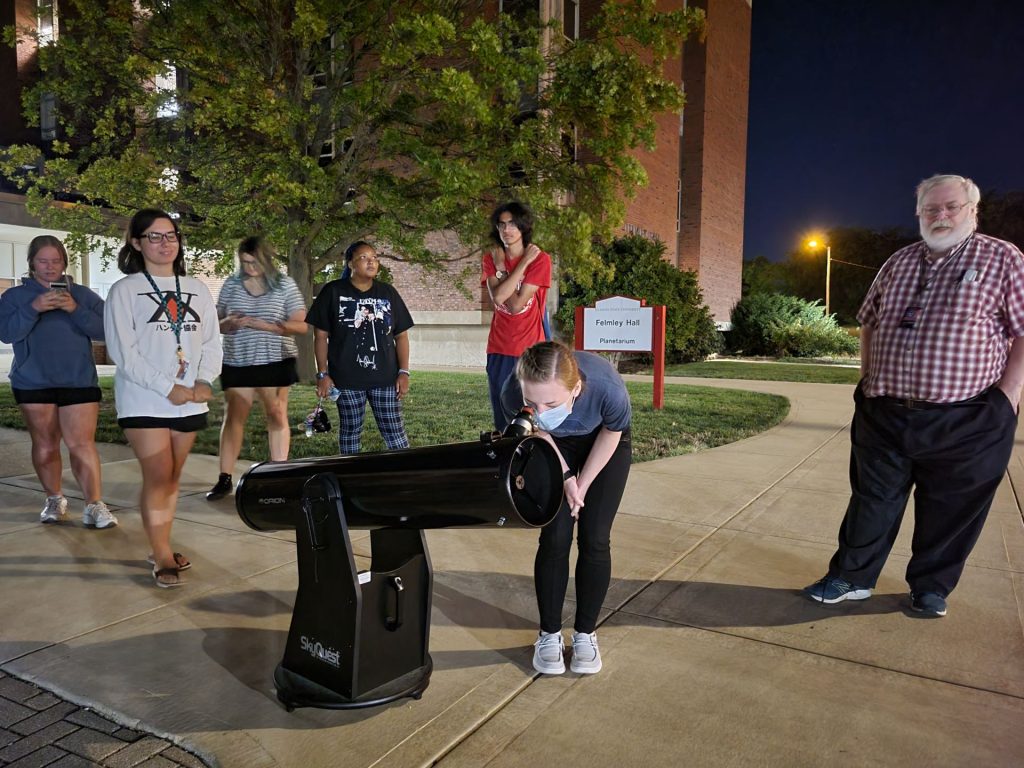Brayden Sefranek’s interest in things beyond the earth’s atmosphere was sparked at the tender age of 6 years old when his father handed him a pair of binoculars and pointed toward the night sky.
“He just said, ‘Check that out,’” Sefranek recalls.
That’s all it took for Sefranek to get hooked. His curiosity in the cosmos was nurtured through books and movies about space, astronomy courses, and family camping trips at his grandfather’s farm in Savanna, just east of the Mississippi River. It was there on a clear and quiet night that he saw the Milky Way for the first time.
When Sefranek enrolled at Illinois State University, he wondered if he would be able to continue to pursue his passion. That question was answered when he discovered Illinois State’s Astronomy Club at a booth during Festival ISU. He met the club’s then-president, Amy Saladino ’23, who encouraged him to join. Two years later, Sefranek is president of the registered student organization (RSO).
“I’m so glad I found this group,” he said.
Illinois State’s Astronomy Club is dedicated to educating students about the universe by hosting star parties and observing the night sky. It meets twice a month at the Illinois State University Planetarium, where several of the group’s members also hold student jobs. “We also do social nights just to bring people together because we are a community,” Sefranek said.
The RSO’s co-advisors are Dr. Jay Ansher, a faculty member in the Department of Physics, and Thomas Willmitch, director of the Planetarium.
“The Astronomy Club has been around a long time and was here when I got here in 2000. It’s gone through periods where it’s been more and less active, and there was a period when there was a heavy emphasis on rocketry,” Willmitch said. “But these days, it’s shifted more toward astronomy and stargazing and that sort of thing, and it’s a really active group right now.”
Sefranek estimates club membership is between 50-70 students, although he admits not all are as active as him. What is remarkable, he said, is the diversity of the club. “I’m a music major and president of the Astronomy Club,” said Sefranek, a junior from Montgomery. “That might not quite compute on the surface, but it shows that anybody can be a member of the club, and anyone can follow their passion for astronomy.”

The group enjoys a close association with the Twin City Amateur Astronomers (TCAA), which hosts monthly events at an observatory at the Sugar Grove Nature Center in Funks Grove. Members of Illinois State’s Astronomy Club are regular attendees to the events where they have access to high-powered telescopes and opportunities to interact with more seasoned astronomers. Willmitch is president of the TCAA, and members include former Planetarium Director Carl Wenning and others with Illinois State ties.
“They really help newcomers to astronomy, members of the Astronomy Club, and people like Brayden,” Willmitch said. “They’ve really helped them get more deeply involved in astronomy.”
The TCAA and Illinois State’s Astronomy Club often gather when certain planets or meteor showers are visible in the night sky, but the biggest date the groups have circled on their calendars is one for some rare daytime viewing. A near-total solar eclipse is forecasted in Central Illinois on April 8, 2024.
“It’s going to be a big deal,” said Willmitch. “The University has already had a planning meeting about it and purchased the eclipse glasses, and they’ll have distribution points for those.”
The University is hoping RSOs can lead the charge in eclipse planning, and the Astronomy Club is ready to play a leading role. “We want to make sure that students all over campus can learn about solar eclipses,” Sefranek said. “We want them to be able to enjoy the fantastic cosmic experience of viewing the eclipse.”
The experience may even spur curiosity like that felt by Sefranek when his father handed him a set of binoculars when he was 6 years old.
And if the stars align—or more accurately, if the earth, moon, and sun align—and more students develop an interest after viewing the eclipse, Sefranek wants them to know they’ll find a community of similarly passionate peers in the Astronomy Club.
“Our club is all about sharing both knowledge and passion, and it’s a great opportunity to meet new people,” he said. “I’ve made friends and really enjoyed getting to know other members, and I hope they feel the same way.”
